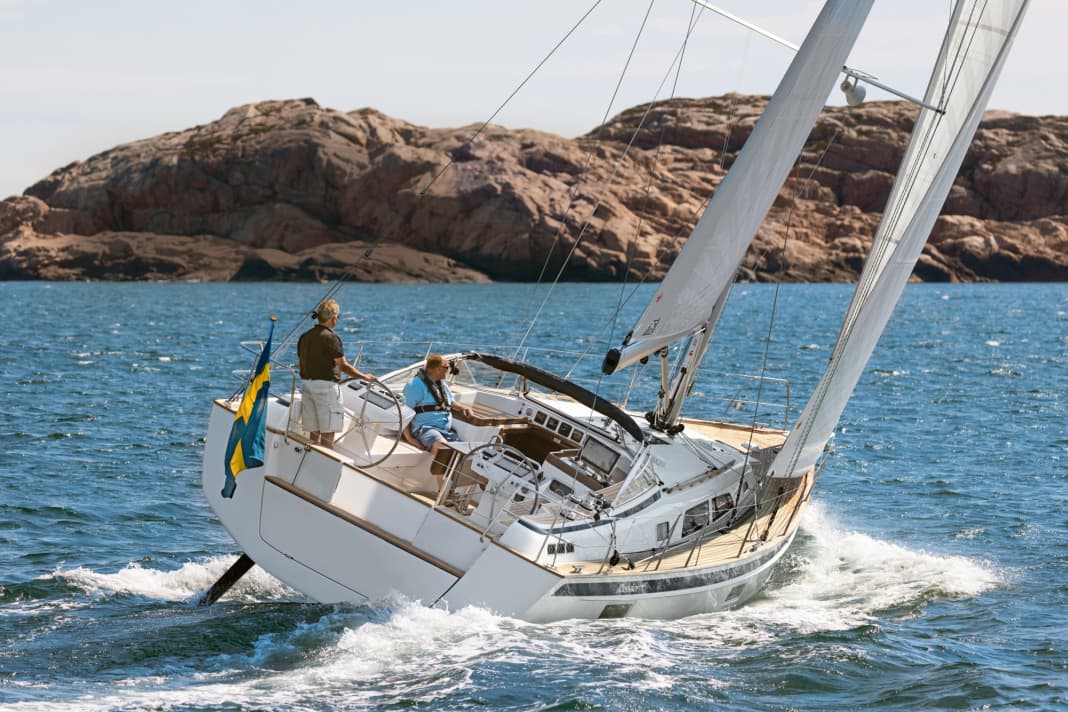





In this article:
It's easy to lose your bearings here. Grey-brown granite rocks wherever you look, some so close together that they look like a single island. The most treacherous, however, remain hidden from view; they lurk just a few handbreadths below the surface of the water. So it's a good thing that three chart plotters in the cockpit display the location and course; two of them are integrated flush into the steering columns and one is behind the fixed windscreen so that the crew always has an overview.
Finding your way through the labyrinth of rocks in the western Swedish archipelago should not be a problem - especially as Magnus Rassy, an expert on the area, is on board and would be able to find a course past the scattered rock formations blindfolded if necessary. Nevertheless, there is a certain tension during the first few miles from the harbour on Orust out into the open Skagerrak.
The Hallberg-Rassy 400 is set to become the star among cruising yachts
It has to do with the boat that was launched just a few days earlier and its not insignificant importance. Many interested parties were waiting for the Hallberg-Rassy 400 when it was presented in summer 2021, because it is equally suitable for coastal and long-distance sailing; one that can be adapted to the needs of small and large crews alike. The Swiss Army knife in the traditional shipyard's programme, if you like: one for almost everyone - at least all those who can spare the equivalent of a detached house.
In order to present the HR 400 in new condition at her first public appearance at the trade fair in Ellös, construction number 1 was craned and pushed back into the hall immediately after the YACHT test in July 2021 so that the golden yellow colour of the immaculately laid teak rod deck would not turn grey prematurely. So the idea of jeopardising the actual premiere because of a navigational oversight is unthinkable.
There is another reason for the latent nervousness on board. Despite hot summer temperatures and a cloudless sky, the wind is blowing freshly from the north-east. A good 5, occasionally even 6 Beaufort gusts chase the gently rounded rocks down to the deep blue sea. Enough to seriously challenge the boat on the first real test run - and to accelerate it well above hull speed in no time at all.
Plenty of wind, plenty of cloth
The standard version of the Rassy already has a sail area of 95 square metres; with the optional membrane sails from Elvstrøm, it has almost 100 square metres, even with a furling mast. Her sail carrying capacity of 4.4 metres is ample for a pure cruising boat and corresponds to that of the comparably sized X 4.0 from X-Yachts. And the Swede is just as energetic.
Hard on the wind she easily reaches 7 knots, half-wind always more than 8 knots through the water. Although the gennaker and code zero are still missing from her inventory and the offshore wind hardly produces any waves that could be used for planing, she can reach an average speed of 9 knots on the beam reach and even up to 11 knots at her peak. A strong debut.
She reveals another virtue on the cross back from the open sea to the sheltered outer archipelago: she makes her best speed to windward at tacking angles of well under 90 degrees; on flat water she can be guided up to 40 degrees on the true wind without losing any significant speed. So if you need to parry a gust of wind or just about manage to get to a jib, the Rassy, whose hull comes from the centre cockpit model 40C, is a good way to pinch height.
Good height, good manners
It's even more fun to let her off the leash on slightly deeper courses. She then rushes past the archipelago and the summer holidaymakers, who usually only have the genoa unfurled on holiday cruises, so quickly that attention is required in the narrower fairways - all the more so as the wind often shifts abruptly by 20 or 30 degrees between the islands.
But despite her speed and temperament, the Rassy behaves with confidence-inspiring calm even then. Once she has reached a heel of around 20 degrees, it takes quite a bit to put her further to one side. As lively as she reacts to an increase in pressure and gains speed, she parries gusts stoically. This is partly due to its high rigidity, which it derives from its 33 per cent ballast content and the stability of its wide frame shape. But it is also thanks to the fully cardanic, absolutely backlash-free steering and the twin rudders.
Designer Germán Frers has positioned the quadrants very far aft and relatively far outboard. The advantage of this arrangement is that the rudder blades offer a high degree of control even when the boat is in a leeward position. The leeward blade then remains fully effective hydrodynamically, while the resistance of the rudder upwind becomes negligible as soon as it dives.
The Hallberg-Rassy inspires confidence even at the limit
A glance at the autopilot's rudder angle display shows just how well this works. Even with a full main and full genoa, the HR 400 can be kept on course close to its reefing limit with minimal deflections; more than 3 to 4 degrees of rudder angle are only necessary in gusts. And if she does reach her limit, it is not followed by a sudden sunburst, but by a soft luff that is signalled in good time and can usually be parried by the helmsman himself. This quickly builds confidence.
If you want, you can let off steam with sheets and halyards. The cockpit layout with the two pairs of winches on the coamings and the large rope boxes behind the stoppers on both sides allows active trimming. You can also easily reach the genoa sheet and - slightly bent forward - the mainsheet from the helm stations.
Only the traveller cannot be released easily because it runs through a lever clamp. On the test boat at the time, the sheet trolley also got stuck on the traveller rail bolted in front of the windscreen; a defect due to excessive manufacturing tolerances or insufficient dimensions. It will be rectified immediately, assures Magnus Rassy.
Otherwise, the cockpit design is almost ideal. The helmsman in particular is perfectly positioned. Because the coaming runs all the way aft at the same height, the boat looks a little bulky from the side. On the other hand, it is easy to lean against it when standing and support your thighs on the sides; if you want to sit on the benches behind the wheel, there is even an armrest. Fold-up platforms ensure a secure stand when the bike is in position. The split and well-spaced backstay hardly gets in the way when sitting on the high edge and not at all when standing.
Small shortcomings, strong substance
It is somewhat surprising that items that are taken for granted in the luxury class, such as the cockpit table, bathing platform and outdoor shower, cost extra. It is also incomprehensible why the genoa rails are a hand's breadth too short to be able to open the headsail in the leech and why the stainless steel platforms for the genoa sheet deflection are not closed but open towards the cockpit so that you can get your foot caught there. Nevertheless, these are the only points of criticism in a rating chapter in which the Rassy is otherwise thoroughly convincing.
In terms of substance, it is beyond reproach anyway. This is illustrated by the elaborate keel construction alone. As always, her ballast is cast from lead, which absorbs impact energy through deformation better than the cast iron commonly used in series boat construction today for cost reasons. And the keel is not bolted directly under the hull; it is suspended from a deep GRP stub with recess, which distributes the forces better and reduces the leverage effect.
"As far as we know, no Hallberg-Rassy has ever been lost due to grounding," says the shipyard boss. Because he wants to keep it that way, he makes no compromises on this point. Even the small bronze bolt, which is accessible from the outside and can be used to lower the bilge when winterising, can still be found on every boat today. Proof that, despite all the changes, the shipyard has remained true to its standards in many respects.
This also applies to the quality of the interior, which was finished in oak on the test boat. Both technically and visually, the woodwork and other installations fulfil very high standards. In addition to sailing characteristics and safety, Hallberg-Rassy's excellent reputation worldwide is based on this.
Great quality, beautiful style
While the HR 400 remains true to the brand image in terms of craftsmanship, its design is fresher, more open and more contemporary than ever. And of course it benefits enormously from the increase in width, which is just as impressive below deck as it is from the outside. It enables options that have never been available in the 40-foot format before in Ellös: with one or two aft compartments, with one or two heads compartments, with an island bed in the foredeck or with a classic V-berth.
However, it is important to choose carefully here. If you don't want to do without three cabins, for example, you will lose the large aft locker to starboard and therefore also the storage space for extensive long-distance equipment - the test boat only had a total volume of 950 litres on deck. That's not enough for a dinghy, additional sails, wheels and other bulky luggage. Below deck, on the other hand, there are plenty of lockers and cupboards.
Surprisingly, the shipyard relies on large sliding doors in the wet cells and galley, just like in the 1980s. Although they allow good access to the pleasingly large storage compartments behind them, they tended to tilt so much in the test that they could only be moved with force. This is neither commensurate with the quality of the other fittings nor the high price level.
Of course, a yacht of this breed and class, built in Sweden, requires a considerable investment. It costs a good 550000 euros with comfort equipment according to the YACHT definition, a good 800000 euros in the de-luxe version tested with bow and stern thruster, electric winches and retractable 40-inch television. Most of the competition, all of which are also well-built, seem almost favourable; only the even more exclusive Contest 42CS is higher.
Measured values Hallberg-Rassy 400
Sailing performance, without drift and current
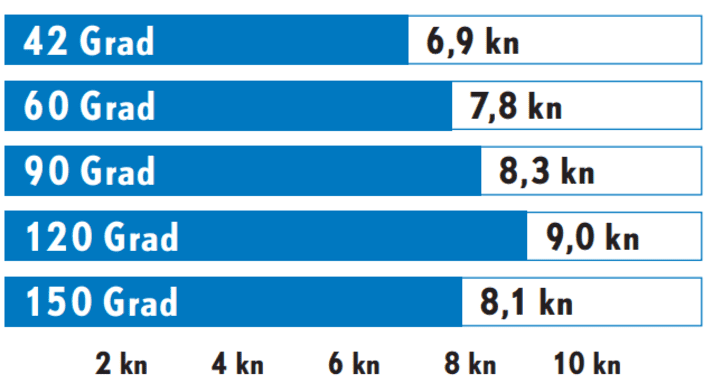
Wind: 16 to 18 kn (4-5 Bft.), wave height: approx. 0.3 metres
Potential STZ*

Good for a cruising boat. Can be increased to 4.5 with an area-optimised sail set
* Dimensionless number. Calculation: 2√S/3√V. The higher the value, the more sail area (S) the ship has in relation to the displacement (V).
Bunk mass
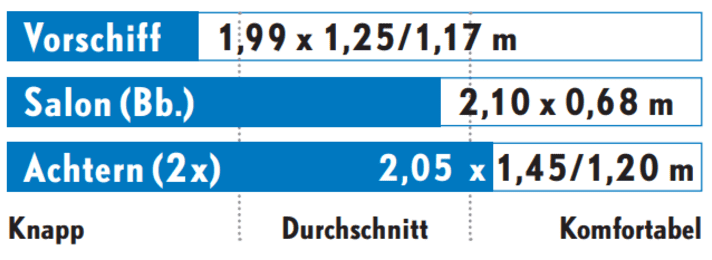
Standing height

Sound pressure
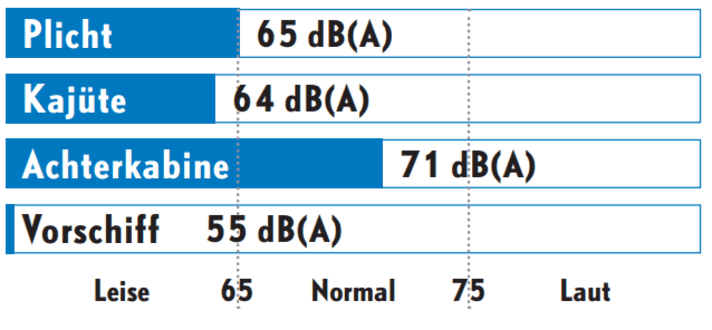
Measured at cruising speed (80 % of maximum speed): 6.9 kn, 1900 min -1
YACHT review Hallberg-Rassy 400
The HR 400 shares its hull and rig with the 40C, its sister model with a centre cockpit. It offers comparable sailing fun, but is more variable in terms of cabin layout. A fascinating cruising boat that knows how to conceal its full-bodied lines at sea
Design and concept
- + Solid and proven design
- + High stability reserves
- + Modern hull lines, lots of volume
Sailing performance and trim
- + High temperament for touring boats
- + Pleasant steering behaviour
- - Traveller hitches under load
Living and finishing quality
- + High-quality woodwork
- + Good ventilation
- - Island berth in foredeck too narrow
Equipment and technology
- + Complete basic equipment
- - Three-cabiners with too little storage space
- - Difficult to access steering gear
Technical data Hallberg-Rassy 400
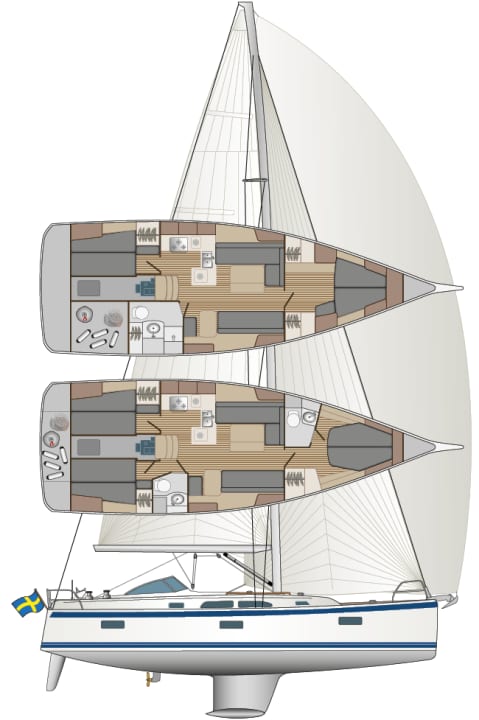
- Design engineer:Germán Frers
- CE design category: A
- Torso length:12,30 m
- Total length: 13,06 m
- Waterline length: 11,74 m
- Width: 4,18 m
- Depth: 1,92 m
- Theoretical torso speed:8.3 kn
- Weight:11,0 t
- Ballast/proportion:3,65 t/33 %
- Mast height above waterline:19,75 m
- Mainsail:51,5 m2
- Furling genoa (110 %):44,2 m2
- machine (Volvo Penta):44 kW/60 hp
- Fuel tank: 400 l
- Fresh water tank:520 l
- Holding tank: 80 l
Hull and deck construction
GRP sandwich laminated in hand lay-up, full laminate in the keel area. Lead keel on GRP stub. Steel frame frame to absorb the rigging forces
Equipment and prices
(all prices as at Q3/2021)
Base price ex shipyard: 516170 €
Standard equipment* included:
Engine, sheets, railing, navigation lights, battery, compass, sails, sailcloth, cushions, galley/cooker, bilge pump, toilet, anchor/chain, fenders, mooring lines, fire extinguisher, electric cooler, holding tank with suction, antifouling, clear sailing handover
Price ready to sail*: 516170 €
Also included in the price:
Teak in the cockpit, bowsprit with anchor bracket, fixed windscreen, genoa furling system below deck, floorboards with real wood veneer
Guarantee/against osmosis: 2/2 years
Surcharge for comfort equipment*
- Line-adjustable hole points: inclusive
- Traveller with line guide: inclusive
- Electric windlass:7050 €
- Tube kicker: inclusive
- Backstay tensioner: inclusive
- Jumping cleats:inclusive
- Sprayhood: inclusive
- Teak in the cockpit: inclusive
- VHF radio: 2940 €
- Log and echo sounder:inclusive
- Wind measuring system: inclusive
- Autopilot: 10500 €
- Charger: inclusive
- Shore connection with RCD: 1930 €
- 230 volt socket (one): inclusive
- 12-volt socket in the sat nav: inclusive
- Heating:9710 €
- Pressurised water system: inclusive
- Hot water boiler:inclusive
- Shower WC room: inclusive
- Cockpit shower:730 €
- Comfort price*: 554630 €
* How the prices shown are defined can be found here !
- Shipyard: Hallberg-Rassy Varvs AB, 47431 Ellös (Sweden), www.hallberg-rassy.com
- Distribution:Hallberg-Rassy Deutschland GmbH, 23730 Neustadt i. H.

